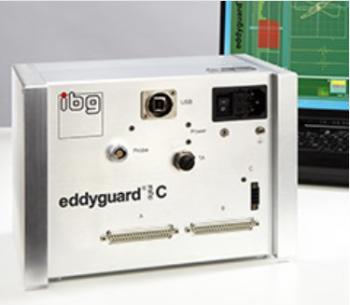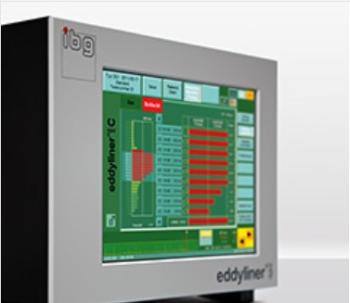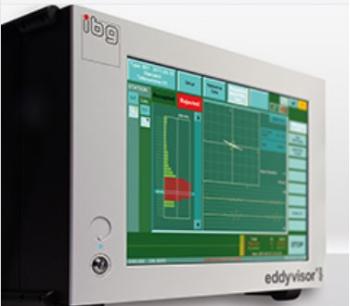eddyvisor®SC Eddy Current Tester Description.
The eddyvisor® distinguishes itself with its high performance modular concept with max. 16 independently working crack detection channels and max. 32 structure test channels all in a very compact design. Additionally, it offers unique features for the realization of sophisticated test tasks using the eddy current technique, combined with the well known ibg test reliability and ease of operation.
The ergonomic interface enables easy and simple operation via touch screen. All functions and test results are captured at a glance. Digital processing of the measuring signal with unique processors, immediately after the pre-amplifier guarantees the greatest possible stability of test results.
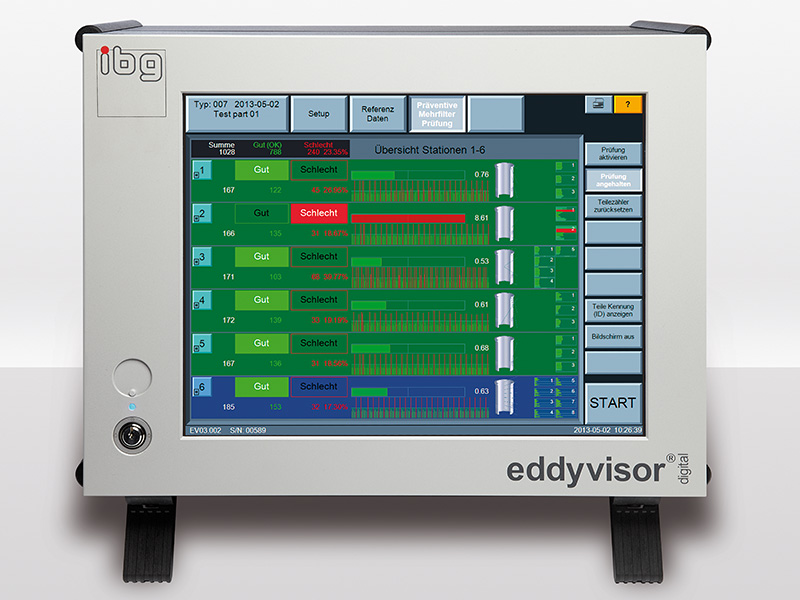
High power, modular test instrument concept with max. 16 independent crack detection channels, max. 32 structure test channels and their combinations.
eddyvisor®SC Eddy Current Tester Description.
The eddyvisor® distinguishes itself with its high performance modular concept with max. 16 independently working crack detection channels and max. 32 structure test channels all in a very compact design. Additionally, it offers unique features for the realization of sophisticated test tasks using the eddy current technique, combined with the well known ibg test reliability and ease of operation.
The ergonomic interface enables easy and simple operation via touch screen. All functions and test results are captured at a glance. Digital processing of the measuring signal with unique processors, immediately after the pre-amplifier guarantees the greatest possible stability of test results.
The eddyvisor® eddy current tester is based on the long proven ibg system concept. All coils, probes, rotating heads and other system components are standardized worldwide. So eddyvisor® is the solution for new tasks and to upgrade existing production machines to equip them with state of the art eddy current technology.
In the field of crack and grinder burn detection, the need for trained experts to perform the sophisticated and time consuming tasks of manual determination and setting of suitable filter band, phase angle and gain is eliminated by ibg's exclusively developed Preventive Multi-Filter Technology (PMFT), which automatically creates tolerance zones by simply scanning good parts. This quantum leap in eddy current technology, unique to ibg worldwide, establishes a new standard for quality in crack and grinder burn detection by the eddy current method.
During material data recording (calibration) with PMFT, surface areas of several good parts are scanned. The good surface eddy current "noise" is recorded simultaneously in each of 30 band pass filters. Tolerance zones, enveloping 360 degrees, are automatically created within each filter band, capturing the allowable eddy current "noise" from good parts. Good part noise signals result from allowable variations in surface roughness and material properties. Thus, the thirty tolerance zones store the part specific fingerprint of the good parts. Edge effects, hardness profile run out, eccentricity, etc. of the good parts are calibrated during material data recording. Thus, pseudo rejected parts are reduced considerably without losing visibility to real flaws.
The unique “good-part-only-concept“ enables setup within a few minutes. Simply scan and record an adequate number of good parts. Tolerance zones within each of the 30 PMFT filter bands are automatically generated capturing the allowable noise from the good parts to form good part finger prints in each of the 30 PMFT filter bands. After material data recording, one key press switches to Preventive Multi- Filter Test, and the test can start. Done! Faster starting yet more reliable eddy current testing is not possible.
Crack and Grinder Burn Detection:
Efforts to reduce content of valuable raw materials and of energy bring reduced cross sections in high volume components in the fields of mechanical engineering and automobile components. The resulting reduced cross sections and stricter material properties requirements have incentivized manufacturers to guarantee correct structure and crack and grinder burn free condition by increased nondestructive testing.
The eddy current test method can be applied for all materials with electrical conductivity or magnetic conductivity (permeability). This includes all metallic materials. The eddy current crack and grinder burn test can be adapted to many test tasks by selecting the suitable crack detection probe and transmitter frequency. As a matter of principle, mainly surface open or flaws close to surface and pores are detected.
The test resolution and effective scan width of a crack detection probe is dependent on core size and type (between 0.5 and 5.0 mm). When testing, a relative movement of probe to surface of test part is always required. In order to test rotationally symmetrical parts for cracks, either the test part is rotated and the probe stands still or the test part stands still and the probe is rotated around the part by means of a rotating head. If more than one line shall be tested additional feed forward is needed. Thus complete surfaces can be scanned. More complicated surfaces require more complicated mechanical handling systems. Our own special machine manufacturing group is always pleased to work with you to design and build an eddy current test system for your 100% testing.
 | Crack detection probe box for contacting testing on eccentric parts like camshaft lobes for cracks and grinder burn; large diameter range is covered; up to 300 rpm (depending on part geometry), ceramic supports for long life-time. Solutions for structure test on camshafts on request. |
In the past, the eddy current crack test would be set to optimally detect an artificially generated (EDM) defect master. But artificial defect masters show different eddy current behavior (i.e., phase shift, etc.) than natural defects. Thus, natural defects could go undetected. Now the ibg technique with its eddyvisor® instrument family walks on new paths. Thanks to the Preventive Multi-Filter Technology and Simultaneous Harmonic Analysis, the instrument is not set to an artificial defect anymore but to the eddy current pattern of "healthy" surfaces of several OK parts. Automatically, 30 tolerance zones over the entire spectrum of filter bands are formed which in fact picture the "healthy" surfaces in the test instrument. As soon as one of these tolerance zones are exceeded by the eddy current signal a NOK signal is triggered, no matter if caused by an artificial or by a natural defect.
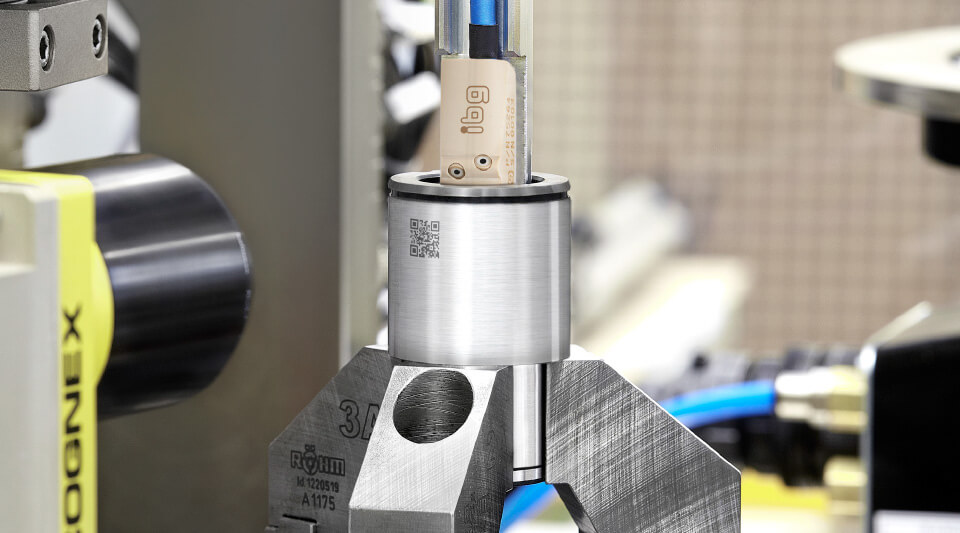 | Steering nut in an automatic ibg test system. Detection of cracks and grinder burn defects on the race inside. With camera inspection system to capture part type specific QR-code. |
For proof of test sensitivity, an artificial defect is put into an OK part by EDM processes. This defect must be 100% detected by the instrument for validation of the method and of the test system. The limit defect of your application is determined beforehand in our lab during a feasibility study. It results in definition of direction and dimension of the smallest reproducible defect that must be 100 % detected without or without significant pseudo rejects.
The well-known note “surface to be free from cracks” on drawings suggests a wish for perfection of the part ibg lathe for lab tests, feasibility studies and small series in crack detection with eddyvisor®. Speed max. 850 rpm, chuck up to 68 mm diameter, with trigger sensor, flexible probe movement. to be produced. However, there are physical limits of the eddy current crack detection relative to that wish. We have committed ourselves to move these limits further in the direction of smaller, detectable “discontinuities” without increases in pseudo rejects and under production conditions. The exploitable sensitivity of the eddy current crack test depends on several parameter:
- Surface roughness - detection of small defects is better the smoother the surface is. The limit is at defect depth equal to 5 times roughness depth, but not less than 50 µm.
- Material - use of differential probes generally suppresses noise inherent to different materials. But the material tested is a factor. For example, the detection limit for lamellar cast iron can increase to approx. 150 µm due to carbon needles in this material.
- Distance probe to surface - increasing probe distance reduces sensitivity, while decreasing probe distance enhance sensitivity to surface roughness and eccentricity of the test part. A good compromise for most applications is the ibg standard probe distance of 0.7 mm.
- Direction of defects - the direction of a defect relative to the probe trace direction also influences the test sensitivity. This can be influenced by choosing the suitable ibg probe system.
ibg mainly applies differential probes for crack detection. The differential principle reduces the very large receiver signal almost to zero by use of two compensating counter rotating receiver windings. This enables very high amplification of very small signals from flaws without overloading the input of the test instrument. Furthermore, ibg places high standards for precision for its own probe manufacturing, further enabling higher amplifications. On the noise side, ibg instruments employ extremely low noise signal processing, earliest possible digitalization and smart signal processes. Thus, ibg is able to combine very high flaw signal amplification with very low noise signal processing allowing larger distances between test probe and test surface without loss of test sensitivity. The advantage realized is that ibg test probes can be held 0.7 mm off of tested surfaces without sacrifice of test sensitivity and test resolution. The small flaws are detected. Other eddy current test equipment manufacturers only guarantee similar sensitivity with 0.2 – 0.3 mm probe distance. But probes so close see more good part noise, and there are more pseudo rejects of good parts. In general, differential probes are highly sensitive for local surface defects. These eddy current probes are also relatively immune to variations in test part structure such as different batches, allowable heat teat variations, etc. These characteristics are important for avoidance of pseudo rejects when doing 100% zero defect testing.
Grinder Burn Detection
As per ISO 14104, grinder burn is a local overheating of surfaces. Heat impact during the grinding process was too much and effected localized annealing or, if heat impact was still stronger, there can be re-hardening zones. Depending on part surface quality and geometric influences, the ibg PMFT detects grinder burn with detection beginning at the level of mere change in residual stress or beginning of annealing zones in the microstructure.
A method applied by ibg to produce reference samples for grinder burn detection is laser burn: heat, defined and locally applied to the surface of the test part. Thus, producing defined artificial defects of different intensity in metallic parts which show analogue features like real damage. They can widely be produced and reproduced at defined spots according to requirements (kind and depth of structure change, spacial dimension) and they serve as master part for validation of automatic test machine as well as for determination of sensitivity of a test systems.
Features crack and grinder burn detection:

- Probes
A selection of probes for crack detection is available which vary in trace width, sensitivity and shape. custom eddy current probes for special applications are designed and manufactured in house. Compact and highly precise ibg rotating heads eddyscan® H and eddyscan® F are available, in many cases installed for optimization of cycle time. They work together with the test instrument eddyvisor®. Cable break monitoring offers high security in continuous operation. - Probe distance
ibg probes are by default manufactured for a large probe/part distance of 0.7 mm. Thus, demands on part exactness and test mechanic are relaxed considerably. - Lift-off compensation
If a part is very eccentric, the distance of probe to test part may be additionally balanced electronically by use of the optional lift-off compensation. Special lift-off compensation probes are supplied for this function. - Suspend
The suspend function blanks out areas not to be tested like holes or similar. - Display
Display of test results as bargraph, xy-diagram with tolerance zones and x(t) and y(t) or three-dimensional C-scan display can be selected. The C-scan (or waterfall diagram) is a rotationally synchronized display of test signal from part circumference enabling local allocation of defects on the surface. - Frequency range
The carrier frequency is selectable within a range of 3 kHz to 10 MHz in 21 steps. The filter frequencies of the 30 band pass filters distribute in the range of 6 Hz to 20 kHz. - Trigger of test
Manually on the instrument, via PLC or by optional start button.
Structure test:
Setting of the instrument is done with good parts only. Ten to 20 parts are presented to the instrument, and tolerance zones are formed automatically. Eddy current signals from subsequent parts are now compared with these good parts. That means that no artificial defects are required for calibration, only known good parts. Due to the high test speed and the easy setup a new test task is ready to start within shortest time. Another advantage is the multi-dimensional analysis of ibg test instruments. An individual tolerance zone is formed for each test frequency. If all tolerance zones are satisfied, one can assume that the tested part is okay. Even one single not satisfied tolerance zone classifies the part as not good.
Eddy current tests are always comparative tests with yes/no answer. Very small deviations in the group of parts can be detected. Eddy current cannot answer why there is a deviation. In case of a bad part another test is recommended like metallurgical methods to inspect the structure (cut) or a classic hardness test.
NEW: Simultaneous Harmonic Analysis iSHA
The relative permeability is strongly influenced by heat treatment processes. Hardened structures have a lower permeability than soft. Because the ibg Preventive Multi-Frequency Technology tests with small magnetic fields hardened OK parts show no saturation effects. It’s within the linear range of the hysteresis curve.
Harmonics occur by each hysteresis of the magnetisation curve of a test part in the coil arrangement. The sinusoidal current in the exciter coil leads to a sinusoidal field strength which induces a magnetic flux in the test part. Its chronological sequence, however, is (depending on formation of permeability) not sinusoidal anymore. Therefore the sequence of the magnetic flux in the receiver coil induces a distorted voltage, deviating from the real sine even at small field strengths. The fundamental waves, having been distorted by hysteresis, contain higher frequency harmonics. Fourier analysis of the distorted fundamental waves reveals the higher frequency harmonics, more precisely harmonics of the 3, 5, 7 or 9 times frequency. The analysis of these harmonics supplies a more detailed view of the magnetic features of the part and thus more exact information on the formation of microstructure. In addition, it offers significant advantages when suppressing interferences like batch scattering, part geometry and part temperature or positioning effects. Harmonic signals are very small. That’s why immense electronic effort is needed in order to distinguish them from the basic noise. Such small signals can be detected clearly and processed robustly by ibg’s unique digital eddyvisor® instrument family.
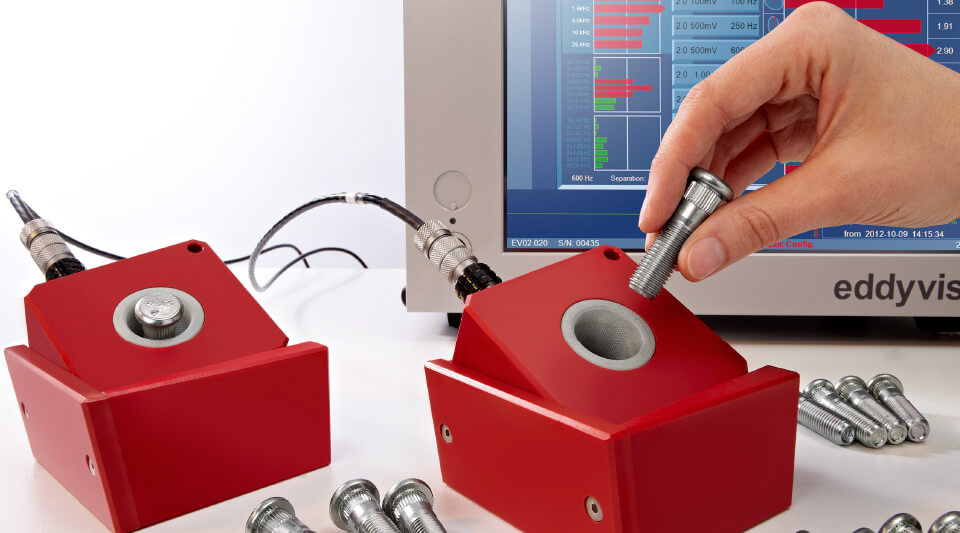 | Fixture for eddy current structure test in the laboratory. |
An essential innovation is iSHA (ibg’s Simultaneous Harmonic Analysis) – combined with ibg’s PMFT it guarantees highest possible test reliability. It enables simultaneous calculation of vectors of the fundamental wave at eight frequencies and of two harmonics without extension of test time. It additionally uses high frequencies and their harmonics for a better solution of even smallest structure differences. Thus iSHA greatly enlarges the possibilities of the well-known Preventive Multi-Frequency Technology.
NEW: Temperature adaptive structure test iTAS
Eddy current testing is based upon the electric conductivity and the magnetic permeability characterising the material to be tested. Different materials and microstructures have different conductivities and permeabilities that are detectible by eddy current. However, both properties also show a temperature dependency. Electric conductivity decreases by 4 % per 10°C. Variations of ambient temperature are compensated by ibg by means of the differential coil principle. Test coil is compensated by a separate compensation coil giving a differential test.
However, test parts are often heated up by production processes and cool down during pauses of production. Thus they have different temperatures when tested. This leads to an erroneous NG sorting.
ibg‘s new Temperature Adaptive Structure Test (iTAS) considers the influence of temperature fluctuation on the measuring values. If the temperature of the test parts can be captured by an external sensor that is directly connected to the eddyvisor®, the influence of the temperature can almost be entirely compensated. Test parts appear as if tested at the same temperature. Pseudo reject is reduced and the test is more precise. The iTAS also enables quick visualisation of how big part temperature influence is in comparison with other parameter fluctuations (batch and dimension differences etc.) for a specific test application.
Features of structure test:
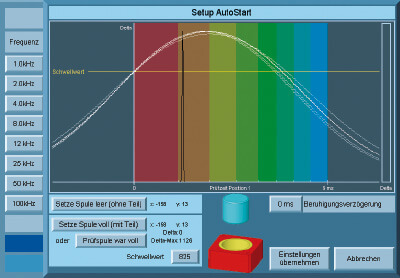 | New: our new AutoStart allows an even faster and more precise start of the structure test than before. The graphic interface makes it very easy to adjust the AutoStart for quick and also for dynamic testing. |
- Tolerance zones
During material data recording the eddyvisor® automatically generates elliptic tolerance zones calculated for reliable testing. A tolerance zone editor is integrated for special situations in the structure test field. A skilful operator may freestyle the fields as rectangle, or ellipse, reduced or expanded, rotated or moved, etc. - Test speed
High speed testing within milliseconds. Using eight test frequencies and standard setting (25 Hz – 25 kHz), only 141 milliseconds are needed for the test. In high speed mode only 1 ms is needed for each test frequency > 5 kHz, very useful for very high speed dynamic testing. - iSHA harmonics analysis
Eight test frequencies of the fundamental wave plus two harmonics (2nd to 9th arbitrary) for each of the eight test frequencies can be utilized without extension of test time. The standard setting is evaluation of the 3rd and 5th harmonic on each of the eight fundamental waves. - Display
Display of test results as bargraph diagram, single ellipse or multiple ellipse display selectable. - Coils
A multitude of standard encircling coils up to a diameter of approx. 500 mm and probes for structure test are available for standard applications. Special applications may be solved by custom designed inner diameter I.D. coils or by rectangular coils which are designed and manufactured in house. Monitoring of coil and cable failure as well as 50/60 Hz noise suppression can be activated. - Triggering of test
Start of test can be done manually at touch screen, via PLC or optional start button. There is an auto-start function that detects the part in the test coil and activates testing immediately or after an adjustable delay time. - Test frequencies
Eight frequencies in a range of 5 Hz to 3 MHz are selectable. - Classification
Sorting of different materials and testing of mixed batches can be accomplished with the ibg classification function (OR-conjunction). Up to seven good part types with different characteristic can be taught and during testing compared to the taught types and classified according to their part type. - Bar and tube test (option)
Bars, tubes and wire can be tested in line to verify material, heat treatment and density differences as well as structure changes. Two proximity switches are used to trigger start and end of test. Nearly the entire bar/tube length is tested. An integrated statistical evaluation of the good versus not good tests (absolute and percentage) is automatically updated. A threshold for an allowable percentage (adjustable) of not good tests can be utilized to eliminate rejects caused by irrelevant local material property variations (e.g. from cold working from handling.


